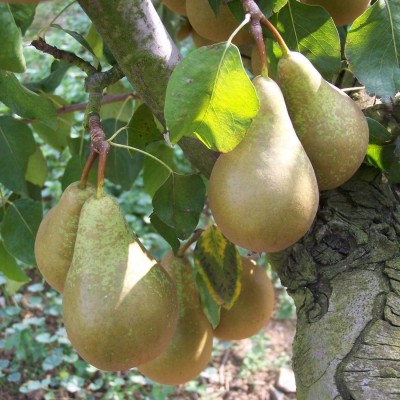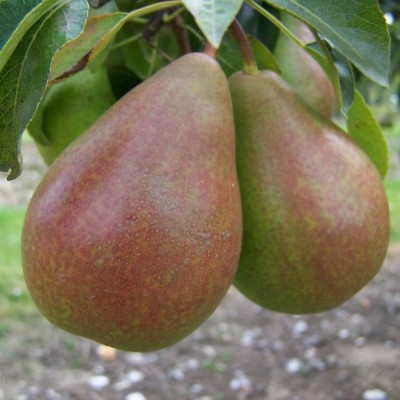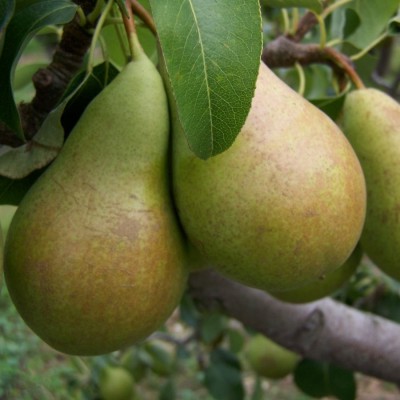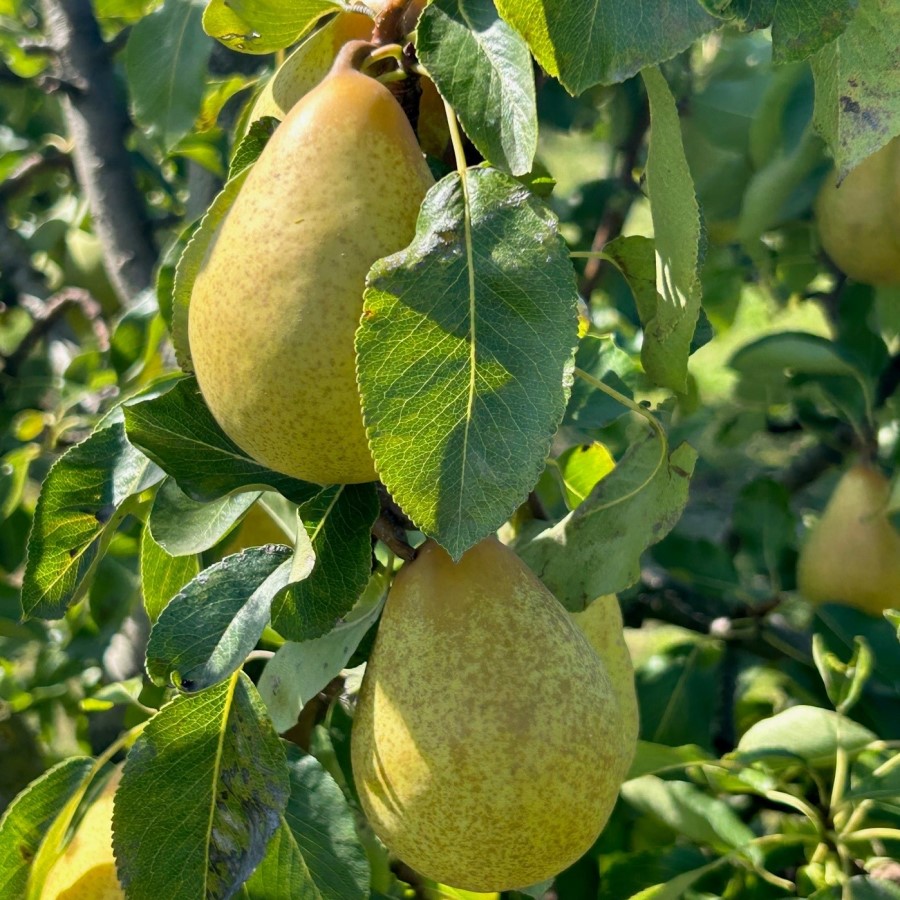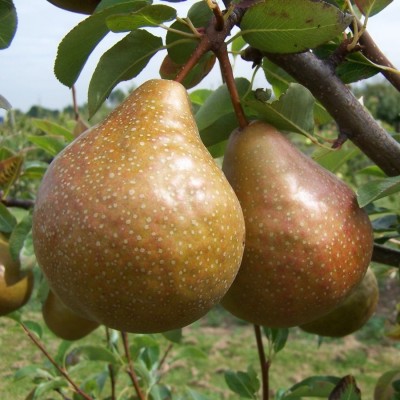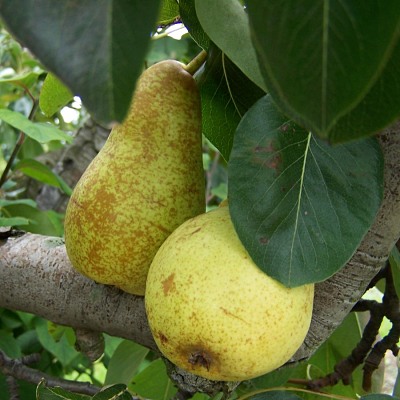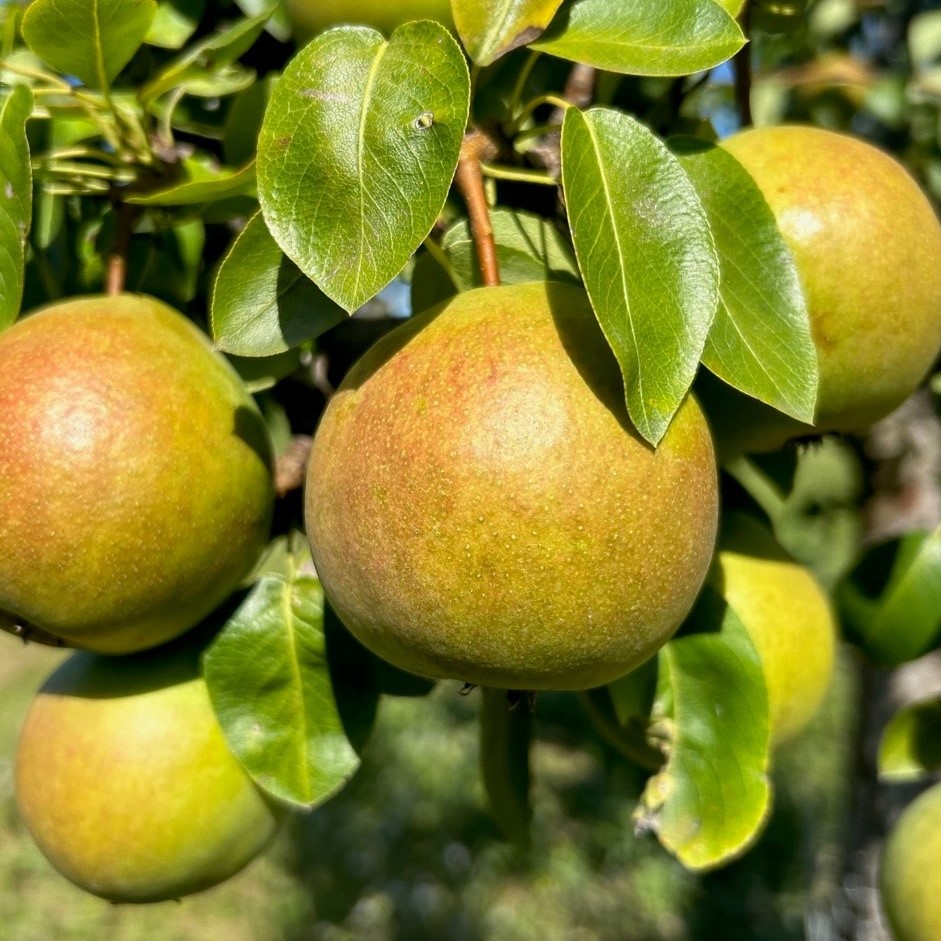Pears are one of the delights of early autumn – yet somehow, they seem to be a more exotic choice than growing apples and come with a reputation for being somewhat problematic. True, they do need a slightly warmer site than some cooking apples and detest cold easterly winds, but will thrive in quite heavy soils, are normally less prone to pests and diseases than other fruit and will live for a long time. A pear tree can easily live to over a hundred years old, so think of it as a long-term investment. As with any investment, it pays to do your research, so let’s look at some of very best pear varieties available.
Conference.
Probably the best known variety in the UK. It was raised at the Rivers nursery in Sawbridgeworth, Hertfordshire and was first exhibited at 1885 at the London National Pear Conference (for which it was specifically named). The first commercial orchard of this variety was planted in 1895, and by the 1930’s it had become the quintessential English pear. Long and thin, covered with a fine brown russet, it crops heavily across almost all of the UK and has the huge benefit of being one of the very few self-fertile varieties. If you only have room for one pear tree, plant this one. Pay no regard to the awful specimens you find for sale in the shops – when perfectly ripe in October they are buttery-soft, full of juice and with an intense pear sweetness.
Buy Pear Conference trees here
Louise Bonne of Jersey.
Raised in Normandy in the 1780’s, and originally called Louise Bonne d’Avranches, this made its way to the UK via the Channel Islands, and was given its current name in 1820. Small oval fruit, with a red flush on the side facing the sun, this is one of the very finest September pears. Very juicy and with a melting white flesh, their sweetness is outstanding. Quite early to flower, but the blossom actually has some frost resistance which many other pears lack. Crops well, but can become biennial (cropping every other year) if left to its own devices. Thin the fruit every year in May and you will avoid this.
Buy Pear Louise Bonne of Jersey trees here
Concorde.
Probably one of the best-known varieties for its flavour is the French variety ‘Doyenne de Comice’ and Comice pears certainly are a delight. However, it is just about the trickiest pear tree to grow, requiring a very sunny sheltered site to produce good fruit. Instead, I much prefer Concorde, which is a cross between Comice and Conference, and has inherited many superb traits from its illustrious parents. The shape is similar to Conference, slightly more rounded, and generally does not have any russeting on the skin. The flavour, however, is almost on a par with Comice – buttery smooth, juicy and with a rich sugary sweetness. Introduced in 1995, it was named after the airliner, in reference to its mixed British and French heritage. Concorde is one of the best garden pears for the UK, and will crop at quite a young age.
Beth.
Bred in the 1930’s by Henry Tydeman (sound familiar? While working at Malling Research Station he bred several varieties of apple, including Tydeman’s Late Orange), this is a cross between the French variety Beurre Superfin and the English pear William’s Bon Cretien. It’s a fantastic garden variety, as it seems to have inherited some of the easy-to-grow nature of the William’s, but with a buttery, melting flavour typical of French pears. Ripe in late August/early September, they are perfect for eating straight from the tree, so avoid that rock hard/ripe/turned to mush rollercoaster ride that some plagues some varieties. Neat and reasonably compact in growth, it is also a superb candidate for training as a cordon or espalier.
Durondeau.
The most handsome of all pears is the variety Black Worcester – the dark chocolate brown fruit develop a burnished, almost metallic, patina as they ripen. As attractive as they are in the fruit bowl, they are inedible raw – rock hard and very gritty – so best used only for cooking or for making perry. Instead, my vote for the prettiest pear variety worth growing goes to Durondeau – the fruit are stunning, the light green skin turns a delicate apricot orange as it ripens, with patches of darker red russeting where the sun has kissed it. Sweet and juicy, and a regular cropper, this should be much more widely planted. Pick in September and enjoy within 4 weeks, otherwise they become a little dry and mealy.
Triomphe de Vienne.
First recorded in 1864, propagated by Claude Blanchet a nurseryman in Vienne, a small town south of Lyon, France. Medium to large oval fruit with a smooth yellow skin, with white juicy flesh that melts in the mouth. An excellent variety for eating straight from the tree in September, it produces good crops most years and tolerates colder and wetter conditions that some others.
Buy Pear Triomphe de Vienne trees here
Scottish Pears.
Pears have a long and important history in France and Belgium – but did you know that for several hundred years Scotland was a hugely important pear growing area? Both around Jedburgh, and further north in the Carse of Gowrie (between Perth and Dundee), monasteries and abbeys were centres for fruit growing from the 12th century. Tax privileges incentivised fruit production, as well as being necessary for self-sufficiency, and large orchards were widely planted. Making use of the rich alluvial soil – some of the best farmland in the country – and the drier weather of the eastern side - Scottish pears were huge demand, transported across the border and to markets as far afield as London. Although almost all the orchards have now disappeared (soft fruit production has taken over in the past 100 years), several old Scottish varieties can still be found in our catalogue – names like Seggie Den, Golden Knap and the Green Pear of Yare. Well worth seeking out!


